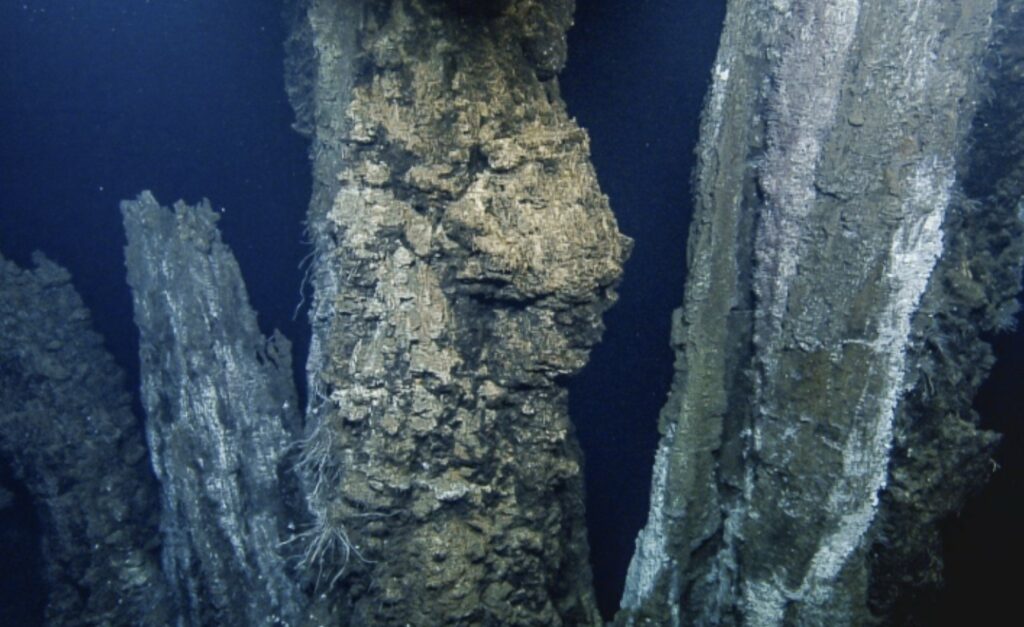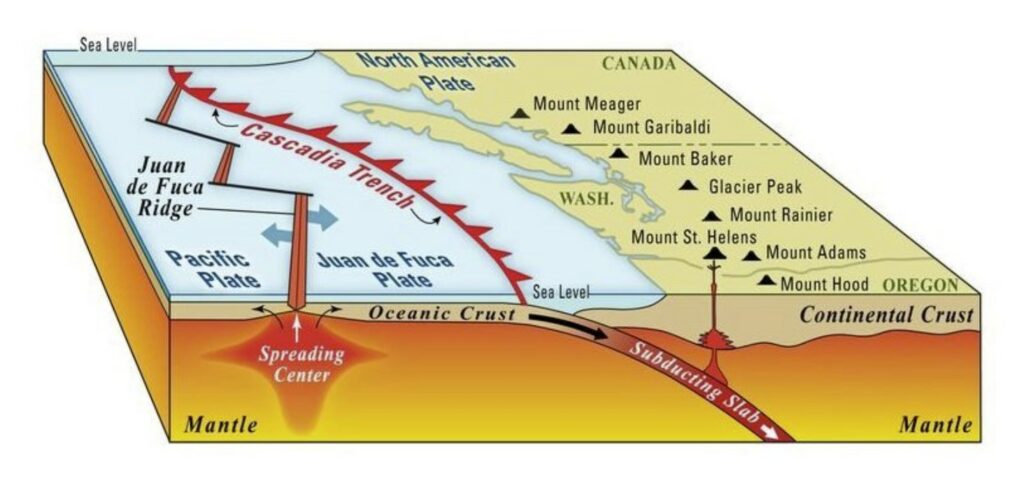
Scientists believe hot magma will erupt under the Pacific Ocean floor in deep waters off Vancouver Island after they detected up to 200 small earthquakes per hour in the area.
They say the expected rupture about five kilometres deep and 260 kilometres off the coast of Tofino, B.C., will be too distant and small to be cause for concern, but offers a unique opportunity to learn more about how the Earth’s crust is formed.
Martin Scherwath, a senior scientist with Oceans Networks Canada, says lava could break through anywhere from weeks to a few years from now, offering the first chance for the phenomenon to be captured by the network’s suite of underwater instruments.
The magma is estimated to be about 800 degrees Celsius but will cool rapidly when it hits the ocean water.
He says “almost fluid, runny rock” will come out of the sea floor, solidify and quickly turn black, while the heat causes the water around it to fizz.
Get ready to rumble 🫨
More than 200 #earthquakes per hour were detected last week at ONC’s NEPTUNE observatory–highest level of earthquake activity in 20 years at the Endeavour site!
Read all about it 👉 https://t.co/p0kxQTd7G6@UVic @InnovationCA #KnowTheOcean #CFIfunded pic.twitter.com/738vEyQbk7
— Ocean Networks 🇨🇦 (@Ocean_Networks) March 11, 2024
Mr. Scherwath says he and fellow geophysicists will be watching to see how much of the Earth’s crust is formed with one eruption, while biologists will be most interested in how animals respond to any changes.
Why no one is freaking out about the looming massive earthquake threat in the Pacific Northwest?
A monstrous earthquake in the Pacific Northwest is a certainty. We just don’t know when.
For many people, natural disasters inspire both fascination and fear. They’re a sign of nature’s power to not only create, but also destroy. At the same time, they’re a reminder of the human potential for ingenuity when it comes to protecting ourselves from the forces we cannot control.
In this case, there are two opposing forces: the North American Plate, an enormous tectonic plate that carries the entire continental United States on its back, versus the 90,000-square-mile Juan de Fuca Plate, located in the ocean off Washington, Oregon, and Northern California. For the past 200 million years, these two have been squaring off in an epic wrestling match in an area known as the Cascadia Subduction Zone, or CSZ. Trust us, nobody wants to see the end of this round. Yet only a few people seem truly bothered: seismologists, emergency management professionals, and those who have experienced earthquakes before.
PROTECT YOUR HOME AND CAR WITH THE BEST LIGHTNING AND EMP PROTECTION AVAILABLE…
It’s certain that the Northwest will experience a devastating earthquake again, says Chris Goldfinger, an oceanographer at Oregon State University and one of the world’s leading experts on subduction zone earthquakes. “We have no idea of the timing and how urgent it is,” Goldfinger tells Pop Mech. “People tend to ignore it in that case.” The majority of the public, as well as most governments in the Northwest, aren’t yet pushing to implement the extensive infrastructure changes and early-warning communications systems needed to save tens of thousands of lives.
The Juan de Fuca Plate has been steadily pushing against the Pacific Coast as it slides beneath the North American Plate. But the roughly 47-million-square-mile North American Plate isn’t budging. Instead, it’s locked tightly against the Juan de Fuca’s surface.
Here’s the chilling prediction from the Cascadia Region Earthquake Workgroup (CREW) in its 2013 report on CSZ earthquakes: “Cascadia has now been building up strain for over 300 years, so the next great earthquake could happen at any time. Reduced to simpler odds, the chances that an earthquake as large as magnitude 9.0 will occur along the zone within the next 50 years are about one in ten.”

Geologists have been watching this bout closely for the past 30 years. They say the CSZ, which stretches from northern Vancouver Island in Canada to Northern California, is bound to suddenly snap back like it did 320 years ago, resulting in double punishment: first the violent upheaval of the land, and then the fury of a wall of water flooding that broken land. Multiple Native American reports about an earthquake and tsunami wiping out communities in today’s Washington state and British Columbia coincide with this time. So do reports from Japan about a tsunami that devastated the Japanese coast the following day.
When it comes again, the earthquake will be magnitude 8.0 or higher, which means the ground will warp and shudder for at least two minutes. That would be considered “the Big One.” However, it’s possible for the entire Cascadia Zone to rupture, turning this earthquake into a disaster movie-level catastrophe.
But there’s still time to prepare, Goldfinger says, and geologists have some good ideas for protecting people and infrastructure in the event of the Big One. We can use Japan as an excellent example of preparedness policy, he says, because Japan has a 1,000-year head start on learning how to live with earthquakes.
“Japan is the most resilient country in the world in preparing for earthquakes. You can have a major earthquake in Tokyo, but there is likely to be not much actual damage,” Goldfinger says. In fact, Japan experiences minor quakes every week. A national initiative for earthquake-resistant code requirements safeguards buildings. Before a quake arrives, early-warning systems automatically warn the public and shut down certain activities, including the railway system and power plants.
PROTECT YOUR HOME AND CAR WITH THE BEST LIGHTNING AND EMP PROTECTION AVAILABLE…
By contrast, no such systematic procedure exists in America. California’s quake resilience has improved somewhat over the past 100 years. Previous quakes on the West Coast have caused enough devastation and loss of life to spur some changes. For example, building codes for new structures now require seismic design to withstand collapse.
Still, the main problem is that there’s no coherent long-term strategy for preparing our nation against earthquakes. “Every town in America is left to its own devices to defend itself,” Goldfinger says. For an unprepared town, even a small earthquake can cause major damage.
“This is a basic, simple thing. We have to start paying the bills a little at a time and save lives, or pay all at once. Earthquakes don’t have to be disastrous,” says Goldfinger. For example, it’s possible to start retrofitting older buildings nationwide, prioritizing schools and hospitals in high-risk regions, he suggests.
To take matters into your own hands, you can consult a program like Shakeout, where people across the world can learn about earthquake drills specific to their region and prepare before a quake hits. More than 3.5 million participants are already registered. You can also turn to ShakeAlert: An Earthquake Early Warning System for the West Coast of the United States, which can alert people of earthquakes on their smartphones. It’s run by the UC Berkeley Seismology Lab in California. [CBC]
Hey friends, it’s time to wake up!
If a few more people choose to support my work, I could expose more lies, root out more corruption, and call out more hypocrites. So, if you can afford it, please support my endeavor by either using PAYPAL or the DonorBox below (PAYPAL & Credit Cards / Debit Cards accepted)…
If you are a crypto fanatic, I do now accept crypto donations:
BTC: 1AjhUJM6cy8yr2UrT67iGYWLQNmhr3cHef (Network: Bitcoin) USDT: 0x490fe5d79d044a11c66c013e5b71305af0a76c1b (Network: Etherum ERC20)
You should join my newsletter to get a daily compilation of different breaking news, pictures and videos… YOU WILL LOVE IT!
Thank you,
Manuel












Actually is has a track record of 250 to 500 year intervals between earthquakes.The average is around 275 to 300 years.It also has a history of completely unzipping.The last two to three have been around 275 years.It needs to be taken seriously.
Based simply on prior quakes, their projection of 1 in 50 years is way too optimistic.Id say more like 90 percent is more likely.Obviously they are looking at data we aren’t currently privy to though.The data leads to that conclusion I guess.Still seems to me like they are playing ostrich though.Stick your head in the sand and ignore the danger.